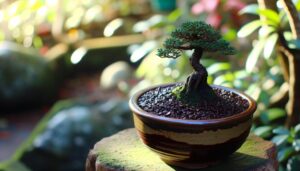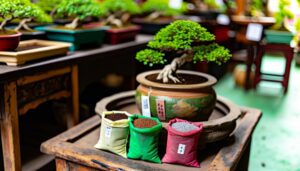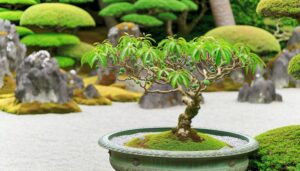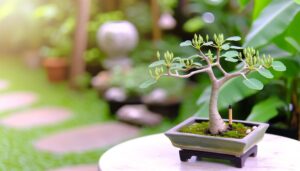Do Bonsai Trees Give off Oxygen?
Bonsai trees produce oxygen through photosynthesis, where chlorophyll in their leaves converts CO2 and water into glucose and oxygen. While the scale and efficiency of oxygen production in bonsai are lower compared to full-sized trees due to limited leaf surface area and biomass, they still contribute to air purification.
Factors such as light intensity, temperature, and CO2 levels notably influence their photosynthetic activity. Additionally, bonsai trees help remove volatile organic compounds and particulate matter, improving indoor air quality.
With proper care and maintenance, bonsai trees can effectively contribute to a healthier indoor environment. Discover more about their fascinating ecological benefits.

Key Takeaways
- Bonsai trees give off oxygen as a byproduct of photosynthesis.
- Oxygen release is directly influenced by light exposure, leaf surface area, and CO2 levels.
- Despite their small size, bonsai trees contribute to indoor air quality improvement.
- Bonsai trees have lower oxygen production compared to full-sized trees due to reduced biomass.
- Effective care and maintenance, such as proper watering and light, optimize oxygen output from bonsai trees.
Photosynthesis in Bonsai
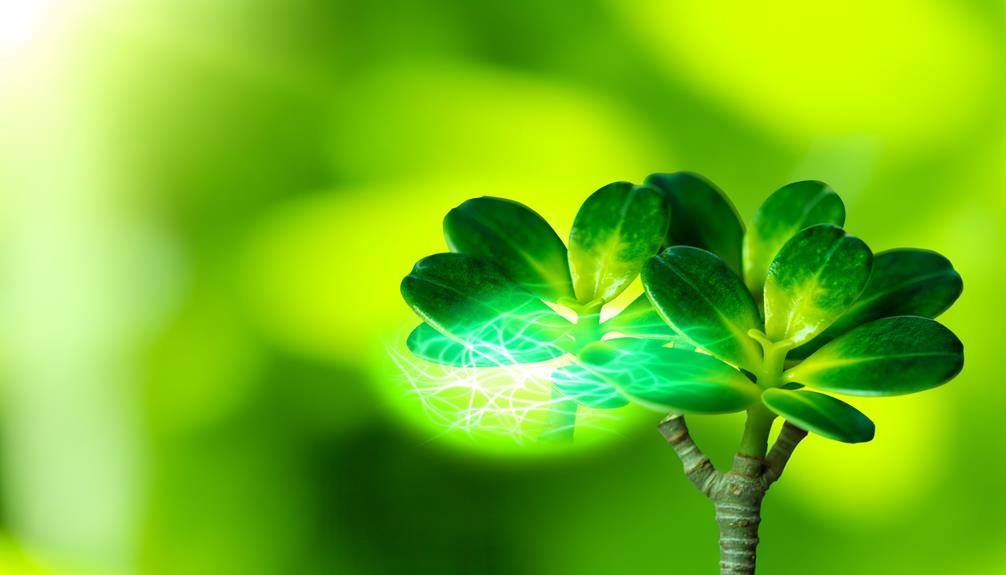
In the context of bonsai cultivation, photosynthesis operates as the fundamental biochemical process by which these miniature trees convert light energy into chemical energy, facilitating their growth and survival.
During photosynthesis, chlorophyll within the bonsai's chloroplasts absorbs photons, initiating a series of reactions that convert carbon dioxide and water into glucose and oxygen. This process is driven by the light-dependent reactions and the Calvin cycle.
Efficient photosynthetic activity in bonsai trees ensures sufficient production of glucose, which is crucial for cellular respiration and growth. Given the constrained environment in which bonsai trees are cultivated, ideal light exposure and proper watering are crucial to maintaining their photosynthetic efficiency.
Understanding this process is essential for bonsai enthusiasts aiming to foster healthy, thriving trees.
Oxygen Production Basics
Oxygen production in bonsai trees is fundamentally tied to the process of photosynthesis, wherein light energy is converted into chemical energy, resulting in the release of oxygen as a byproduct.
The rate at which bonsai trees release oxygen is influenced by factors such as leaf surface area, light intensity, and ambient carbon dioxide levels.
Understanding these variables allows for a thorough analysis of the efficiency and capacity of bonsai trees in contributing to atmospheric oxygen levels.
Photosynthesis in Bonsai
Photosynthesis in bonsai trees, as in all green plants, involves the conversion of light energy into chemical energy through complex biochemical processes, resulting in the production of oxygen as a byproduct. This process primarily occurs within chloroplasts, where chlorophyll pigments capture light energy.
The energy is used to convert carbon dioxide and water into glucose and oxygen. The general equation for photosynthesis is 6CO₂ + 6H₂O + light energy → C₆H₁₂O₆ + 6O₂.
In bonsai trees, despite their miniature size, the fundamental mechanics of photosynthesis remain consistent with their full-sized counterparts. Stomata on the leaves facilitate gas exchange, allowing CO₂ uptake and O₂ release. Consequently, bonsai trees contribute to oxygen production through these intricate, yet essential, metabolic pathways.
Oxygen Release Rate
The rate at which bonsai trees release oxygen is dependent upon several factors, including their species, age, leaf surface area, and environmental conditions such as light intensity and carbon dioxide concentration.
Photosynthesis, the biochemical process responsible for oxygen production, occurs in the chloroplasts of leaf cells, where light energy converts carbon dioxide and water into glucose and oxygen.
The efficiency of this process varies; younger, vigorously growing bonsai with a larger leaf surface area can potentially produce more oxygen compared to older, less active specimens.
Additionally, ideal light conditions enhance photosynthetic activity, thereby increasing oxygen output. Understanding these dynamics is essential for maximizing the ecological benefits of bonsai trees, especially in indoor environments where air quality is a concern.
Factors Affecting Output
Understanding the multifaceted factors that influence oxygen production in bonsai trees requires an examination of both intrinsic botanical characteristics and external environmental conditions.
Intrinsically, species-specific photosynthetic rates and leaf surface area are key, as they directly affect the tree's ability to produce oxygen.
Externally, factors such as light intensity, ambient temperature, and carbon dioxide concentration play significant roles. Best light conditions enhance photosynthetic efficiency, while temperature influences enzymatic activities within chloroplasts.
Additionally, adequate CO₂ levels are essential for the Calvin cycle, the biochemical pathway responsible for carbon fixation.
Hence, a comprehensive understanding of these variables is necessary for maximizing the oxygen output of bonsai trees, ensuring both their health and their contribution to indoor air quality.
Comparing to Full-Sized Trees
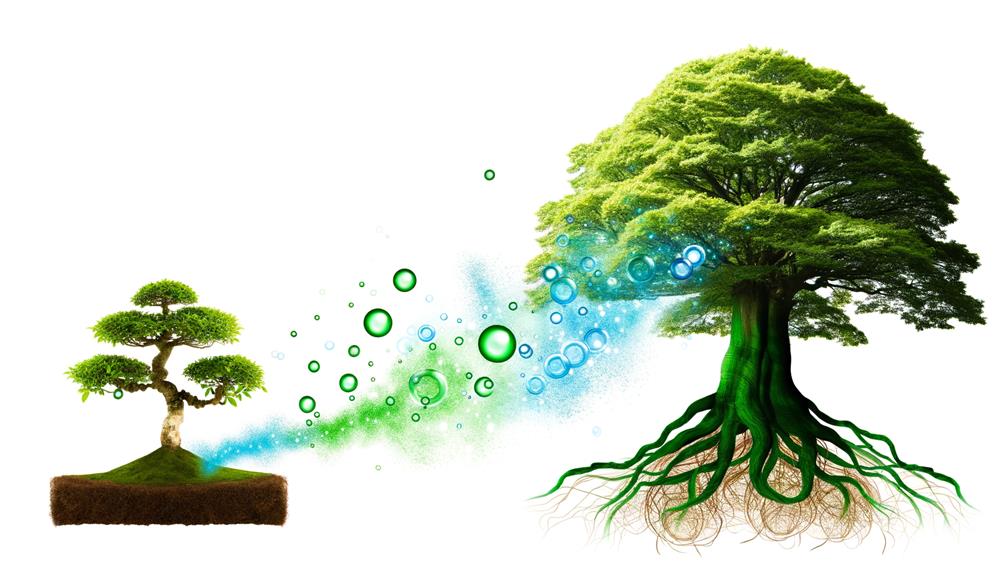
When comparing bonsai trees to their full-sized counterparts, it is important to assess the oxygen production efficiency relative to their biomass.
Additionally, the space and maintenance requirements of bonsai, which are notably reduced, present unique advantages and limitations.
Understanding the distinct environmental impacts of bonsai and full-sized trees further elucidates the broader ecological implications of cultivating each type.
Oxygen Production Efficiency
Despite their miniature stature, bonsai trees exhibit a much lower oxygen production efficiency compared to their full-sized counterparts due to their reduced leaf surface area and overall biomass. Leaf surface area is a critical factor in photosynthesis, the process by which plants convert light energy into chemical energy, releasing oxygen as a byproduct. Full-sized trees possess extensive canopies, facilitating a larger photosynthetic area, thereby producing more oxygen.
Additionally, the overall biomass of full-sized trees supports greater metabolic activity and higher rates of gas exchange. In contrast, bonsai trees, constrained by their intentionally limited growth, have fewer leaves and less biomass, leading to decreased photosynthetic capacity. Consequently, while bonsai trees do produce oxygen, their contribution is markedly less significant.
Space and Maintenance Needs
In addition to their reduced oxygen output, bonsai trees require much less space and have unique maintenance needs compared to full-sized trees, making them suitable for indoor environments and small-scale horticulture. The compact size of bonsai trees allows for a controlled growth environment, minimizing spatial constraints. Regular pruning, root trimming, and meticulous watering schedules are essential to maintain their miniature stature and health. In contrast, full-sized trees demand extensive spatial allocation and less frequent, albeit more intensive, maintenance.
| Aspect | Bonsai Trees | Full-Sized Trees |
|---|---|---|
| Space Requirement | Minimal, suitable for indoor settings | Extensive, requires outdoor space |
| Maintenance Routine | Frequent, detailed | Less frequent, but extensive |
| Growth Control | High, through pruning and trimming | Low, natural growth |
This delineation highlights the practical advantages of bonsai trees in limited-space environments.
Environmental Impact Differences
Bonsai trees, while aesthetically appealing and suitable for confined spaces, exhibit a noticeable decline in environmental impact concerning carbon sequestration and oxygen production compared to their full-sized counterparts. Due to their diminutive size, bonsai trees have a lower biomass, which directly relates to their limited capacity for photosynthesis. This reduced photosynthetic activity translates to reduced oxygen output and minimal carbon dioxide absorption.
Additionally, the restricted root systems of bonsai trees limit their nutrient uptake, further affecting their growth and metabolic efficiency. In contrast, full-sized trees, with extensive root networks and larger leaf surface areas, contribute significantly more to atmospheric purification processes. Thus, while bonsai trees offer unique aesthetic and spatial benefits, their environmental contributions are notably inferior.
Air Quality Contribution
The contribution of bonsai trees to air quality is primarily attributed to their ability to engage in photosynthesis, a process that absorbs carbon dioxide and releases oxygen. Through photosynthesis, bonsai trees convert light energy, water, and carbon dioxide into glucose and oxygen. This biochemical process not only mitigates carbon dioxide levels but also enhances ambient oxygen concentrations.
Moreover, bonsai trees contribute to the removal of volatile organic compounds (VOCs) and particulate matter from the air, thereby improving overall air quality. The stomata on bonsai leaves facilitate gas exchange, aiding in the filtration of airborne pollutants. This dual action of oxygen release and pollutant absorption underscores the significance of bonsai trees in indoor air quality management.
Impact of Size on Oxygen
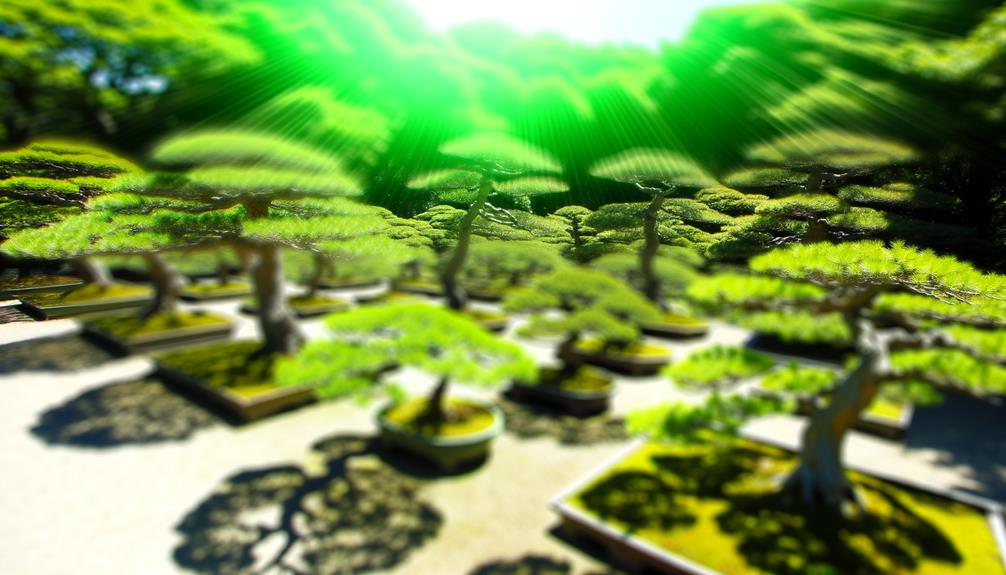
While the oxygen output of bonsai trees is a direct function of their photosynthetic activity, their diminutive size inherently limits the volume of oxygen they can produce. Photosynthesis rates are proportional to leaf surface area and chlorophyll content, both of which are notably reduced in bonsai compared to full-sized trees. This limitation is accentuated by the constrained root systems and reduced biomass, which further restricts their ability to absorb carbon dioxide and produce oxygen.
| Factor | Bonsai Trees |
|---|---|
| Leaf Surface Area | Markedly Reduced |
| Chlorophyll Content | Lower |
| Biomass | Limited |
Consequently, though bonsai trees do contribute to oxygen production, their impact is minimal when compared to larger trees. Understanding these limitations is essential for realistic expectations of their air-purifying capabilities.
Indoor Vs. Outdoor Bonsai
The dichotomy between indoor and outdoor bonsai trees profoundly influences their oxygen output. This is primarily due to variations in growth conditions such as light exposure, humidity, and temperature.
Species suitability for indoor environments, often tropical or subtropical varieties, contrasts with temperate species that thrive outdoors. This environmental bifurcation necessitates an analysis of how each setting optimizes photosynthetic efficiency and, consequently, oxygen production.
Growth Conditions Impact
Understanding the impact of growth conditions on bonsai trees, particularly the differences between indoor and outdoor environments, is important for optimizing their health and oxygen output.
Indoor bonsai trees often face limited light exposure, reduced humidity, and constrained air flow, which can inhibit photosynthetic efficiency and hence, oxygen production.
Conversely, outdoor bonsai benefit from natural sunlight, fluctuating temperatures, and greater air circulation, fostering robust photosynthesis and superior oxygen output. Additionally, outdoor conditions promote stronger root development and healthier foliage, important for sustained metabolic activity.
However, outdoor bonsai must also withstand environmental stressors such as pests and extreme weather.
Thus, balancing these conditions is necessary to maximizing the physiological health and oxygen-generating capacity of bonsai trees.
Species Suitability
Selecting the appropriate bonsai species for indoor or outdoor cultivation necessitates a detailed understanding of each species' specific environmental requirements and physiological adaptations. Different species have distinct needs regarding light, temperature, humidity, and airflow. For effective bonsai cultivation, one must consider:
- Light Requirements: Species like Ficus prefer bright, indirect light, making them suitable for indoor settings, whereas Junipers thrive under full sunlight, ideal for outdoor placement.
- Temperature Tolerance: Tropical species, such as the Jade plant, require warm, stable temperatures found indoors, while temperate species like the Japanese Maple need seasonal temperature variations.
- Humidity Levels: Indoor bonsai often need higher humidity levels, achievable through misting or humidity trays.
- Airflow and Ventilation: Outdoor bonsai benefit from natural air circulation, essential for preventing fungal infections.
Understanding these factors ensures the best growth and oxygen production.
Common Bonsai Species
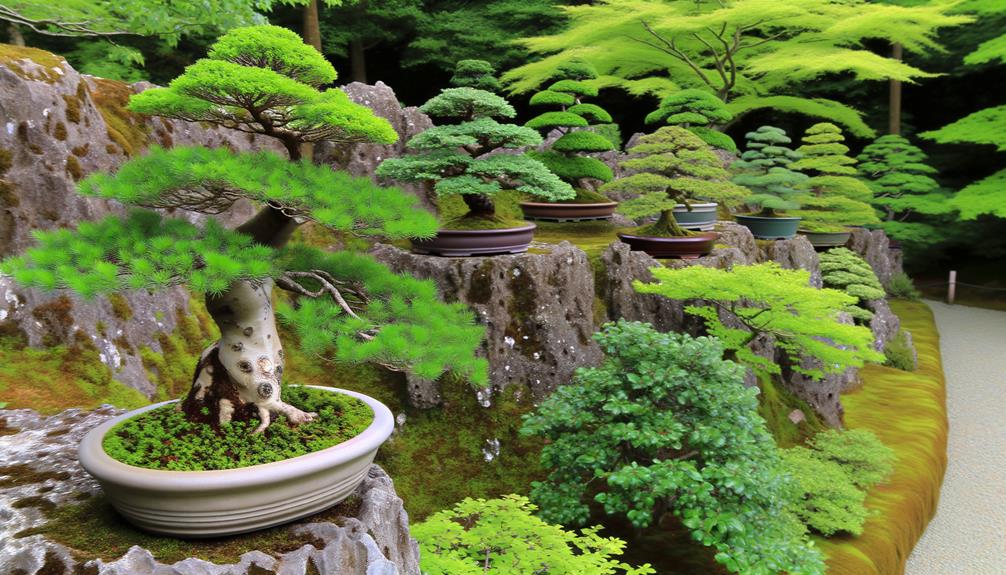
Among the myriad species cultivated as bonsai, Ficus retusa, Juniperus procumbens, and Acer palmatum stand out due to their adaptability to miniaturization and their physiological responses to pruning and environmental conditions. Ficus retusa, known for its robust root system, exhibits strong resilience to varied light conditions. Juniperus procumbens, a conifer, is esteemed for its needle-like foliage and ability to thrive in less fertile soil. Acer palmatum, or Japanese maple, is prized for its striking foliage color changes and fine branching structure. These species, through photosynthesis, contribute to oxygen production, an essential ecological function.
| Species | Notable Traits | Environmental Adaptability |
|---|---|---|
| Ficus retusa | Robust root system | Varied light conditions |
| Juniperus procumbens | Needle-like foliage | Less fertile soil |
| Acer palmatum | Striking foliage color changes | Fine branching structure |
Care and Maintenance
Correct care and maintenance of bonsai trees require a thorough understanding of their specific watering, pruning, and soil requirements to guarantee excellent health and growth. This necessitates an analytical approach and precise attention to detail:
- Watering: Maintain consistent soil moisture without waterlogging. Utilize well-draining soil mixes to sustain ideal hydration levels.
- Pruning: Regular trimming controls growth, encourages ramification, and preserves the desired shape of the bonsai.
- Soil Composition: Use a balanced mix of organic and inorganic components to facilitate sufficient nutrient availability and root aeration.
- Environmental Conditions: Sustain appropriate light exposure and temperature ranges specific to the species of bonsai, ensuring photosynthetic efficiency.
Adhering to these principles fosters robust bonsai trees capable of effective oxygen production.
Benefits for Health

The presence of bonsai trees in living and working environments contributes to improved air quality through enhanced oxygen production and the absorption of airborne pollutants. By engaging in photosynthesis, bonsai trees convert carbon dioxide into oxygen, which is essential for human respiration.
Moreover, bonsai trees act as natural air purifiers by trapping particulate matter and absorbing harmful chemicals such as formaldehyde, benzene, and trichloroethylene. This reduction in indoor air pollutants can diminish respiratory irritations and allergic reactions.
In addition, the aesthetic appeal and tranquil nature of bonsai trees have been shown to reduce stress levels and promote mental well-being. Studies indicate that proximity to greenery can lower blood pressure and improve concentration, making bonsai trees a valuable addition to health-centric environments.
Environmental Impact
Bonsai trees, through their miniature yet effective photosynthetic processes, contribute positively to the environment by enhancing local air quality and providing microhabitats for various small organisms. Despite their size, bonsai trees play a significant role in environmental sustainability. The following points highlight their ecological impact:
- Oxygen Production: Bonsai trees engage in photosynthesis, converting carbon dioxide into oxygen, albeit on a smaller scale.
- Carbon Sequestration: These trees absorb atmospheric CO₂, helping mitigate greenhouse gas effects.
- Air Purification: Bonsai trees filter airborne pollutants, improving indoor air quality.
- Biodiversity Support: They create microhabitats for insects and microorganisms, fostering local biodiversity.
Thus, bonsai trees, while diminutive, offer considerable environmental benefits.
Conclusion
Despite their diminutive stature, bonsai trees engage in photosynthesis and contribute to oxygen production, albeit on a limited scale compared to full-sized trees.
Ironically, their small size, which captivates human admiration, simultaneously restricts their capacity to greatly enhance air quality.
Various species, meticulous care, and maintenance practices guarantee their health benefits. Yet, the environmental impact remains modest.
Therefore, bonsai trees symbolize a delicate balance between aesthetic appeal and ecological functionality, underscoring nature's intricate interplay between form and function.

